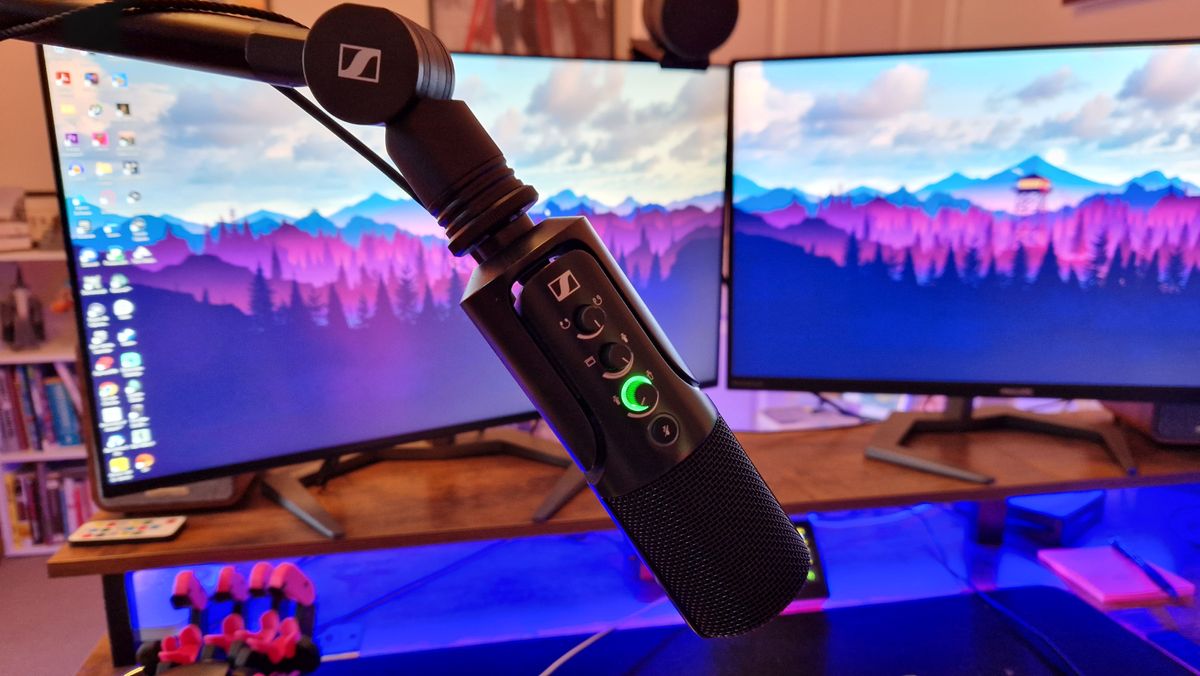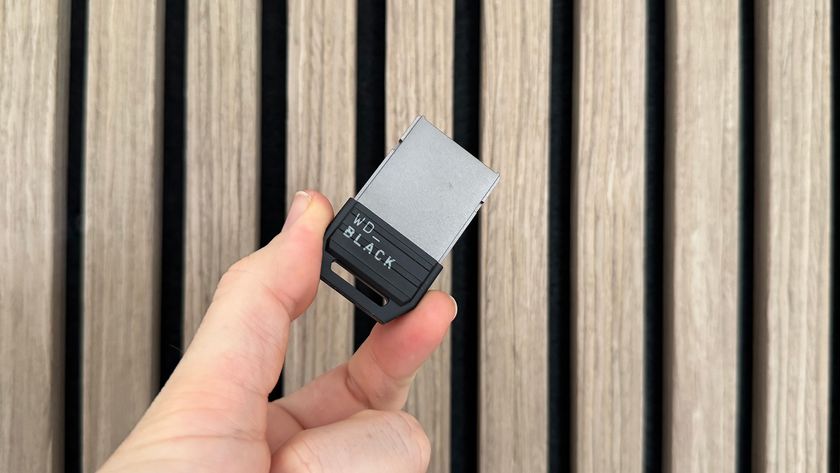12DOVE Verdict
The Sennheiser Profile USB mic is a solid microphone for content creation, streaming, and gaming because you very much get what you pay for. I wouldn't call it entry-level since it has a really solid cardioid capsule and a $100 price tag. That said, it lacks the features that take its rivals further up the ranks.
Pros
- +
Affordable price
- +
Decent sound quality
- +
Good cardioid capsule and distance control
- +
Solid boom arm
Cons
- -
Lacks bass response
- -
Can lack power
- -
No software and short on features
Why you can trust 12DOVE
The Sennheiser Profile USB mic and boom arm are a solid solution for content creators who want decent audio quality without breaking the bank. It's placed in a bit of a tricky position in the market though, because it separates itself from truly basic entry-level mics while lacking so much of what makes its competitors great.
We say it almost every time we review one, but the best microphones for streaming and gaming have their work cut out for them. There are so many mics out there these days and they all have a lot going for them, so it can be truly difficult for non-established brands to make a dent. Some opt for software to help them stand out, others focus on pure audio quality or plain old convenience. Sennheiser is definitely in the latter camp in that regard.
For just $100/£100, you can get the Profile USB mic, but for $179/£149 you can get the streaming set, which bundles in the brand's accompanying boom arm. At that kind of price range, where does this mic fit in amongst a competitive field?
Design & Features
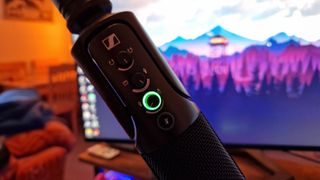
The EPOS B20 may be the closest relative of the Sennheiser Profile USB that we've tested previously. With that now beginning to age, however, Sennheiser has made the wise decision to make the design of its new USB mic a little more down to earth. The Profile isn't trying to compete with the biggest, baddest mics like the Shure's of the world, but it maintains a classic black chassis and professional-looking grille all the way around its top.
Perhaps most handy, is its tilt functionality which I really like because you can benefit from it regardless of whether you put it on a boom arm or sit it on a table. The tilt is built into the microphone's body, and that's a nice degree of convenience to have for this price. On top of that, it also has a self-locking joint for when you find the correct angle you want it to sit at.
You can really tell Sennheiser wanted to focus on convenience because most of the value for money with this mic comes from its three tuning dials. With one, you can control the gain of the mic, with another you change the monitoring level, and with another, you can fine-tune your mix - how the mic fits in with the rest of your audio devices. Above all of those, you'll find a soft-touch mute button with an LED ring that indicates if your mic is hot or not. The gain control dial has a similar indicator that shows you if you're clipping, too.
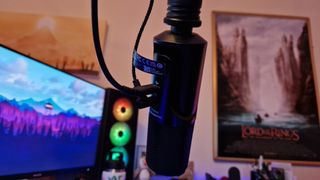
The mic itself uses a metallic chassis which feels nice and premium. Considering you can get more expensive microphones like the SteelSeries Alias that don't utilize metal chassis, that is a bonus. Around the back of the microphone, you'll find a USB-C port for connecting it to one of the best gaming PCs and a 3.5mm headphone jack.
The boom arm you'll get if you opt for the streaming set is pretty fantastic. The brace that locks it down to one of the best gaming desks is pretty standard, but it has an integrated cable management slot that runs along its entire length to help you keep cables out of the way. I found this to be a real perk for the 1.2m included cable, which, I'll admit, could have been a bit longer.
Other than that, there's not much to speak about when it comes to features. There's no included pop filter, there's no partner software or helpful firmware. This feels glaringly lacking, in all honesty, especially when so many other brands include these things.
Performance
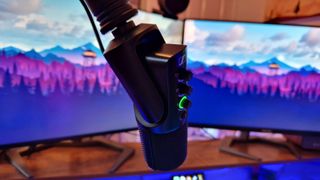
When I'm not testing the latest gaming tech out, I run a YouTube channel in my free time where I talk about game design. As someone who takes a pretty perfectionist approach to those videos, liking a microphone enough to use it for one of them is a solid test of whether I can recommend it or not. I'm happy to say that after using the Blue Yeti Nano for a little over a year and a half, I was happy to make the switch to the Sennheiser Profile USB. While I think both produce some great sound quality for the money, I do miss the bass response of the Yeti Nano.
I haven't been blessed with the low dulcet tones of your average late-night jazz radio host, so I prefer a mic that won't enhance the treble that's naturally there and instead give my VO a bit of a bassy bost. Without any software to naturally help that, Sennheiser does suffer a bit. If you want a more practical example, you can compare how my voice sounds in this video about The Last Clockwinder, and in this one where I talk about The Cosmic Wheel Sisterhood. Keep in mind that both VO tracks went through the exact same dynamics processing editing.
When recording VO with the Sennheiser Profile, I found that no matter what distance I was away from the mic, no matter how I configured the tuning dials on the mic's front, and no matter how I changed my vocal, I couldn't get a very lively response from it. It was nearly impossible to peak, and even if I am fairly soft-spoken, other mics have been a bit more dynamic for me in the past.
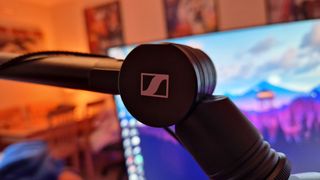
This is a bit of a double-edged sword, because it means you can count on the Profile USB to save you from clipping, and you'll get consistency during live streams if you don't want your mic right up on your chin. On the other hand, it means you have less to play around with when it comes to editing tracks, whether that's music, VO, or a podcast. I'd rather have a broader range of dynamics I can play around with in editing than a fairly muted track that hasn't picked up the different ranges I've tried to put into place when recording.
A real benefit to having a solid cardioid capsule with off-axis rejection is distance control though. Talking to friends on Discord calls while playing a game can be a bit of a pain without this because more times than not your mic will need to be on the tip of your nose and will probably end up blocking a section of your best gaming monitor. Regardless, I did like being able to turn my monitoring level up and down without messing with gain at the same time. I felt I could do so accurately when I plugged in my Razer Moray in-ear monitors, and this sort of control can sometimes be reserved for audio interfaces like the BEACN Mix Create.
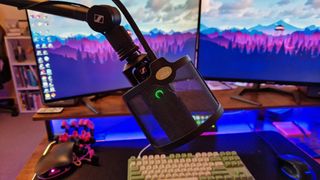
I don't have many complaints with the sound quality of this mic overall - it still produced some decent voice-over tracks for me - it's just hard not to imagine what kind of software support and extra features you could get from something that's only $40-$50 more in the USB space.
The only other thing I think that's worth mentioning is that the boom arm is great, and I'll probably continue to use it from now on. That cable management slot really does a world of good. I just wish the pivoting joints on it weren't so tight because it frequently starts to come out of its desk mount socket after moving it into position.
Should you buy the Sennheiser Profile USB mic?
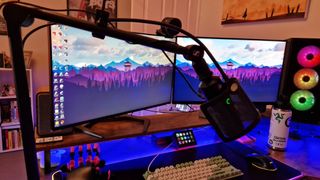
If you're a content creator who's just starting out, or you're a PC gamer looking for a better mic to chat to friends with, the Sennheiser Profile USB mic is pretty recommendable. It's not cheap for a simple gaming mic, but you will get really decent audio quality from it, with the convenience of those three tuning dials and no faff of playing around in software.
If you're anything more than that - a semi-professional content creator, streamer, or podcaster looking for a more bass-heavy mic, maybe look to save up a bit more and grab something that gives you more for your money. USB mics are, by their nature, plug-and-play, but that doesn't mean they can't offer you more than that.
How we tested the Sennheiser Profile USB mic
I used the Sennheiser Profile USB mic as my central microphone for gaming, content creation, and work calls for a few months before this review was written. In that time I recorded three or four VO tracks for YouTube and put in plenty of hours in Discord calls with friends. I tested different gain configurations, different distances, and voice timbres to see what kind of recording I'd get back, and thoroughly edited the waveform after the fact.
For more on how we test the latest mics here at 12DOVE, check out our hardware policy.
Looking for more streaming gear? Here are the best capture cards, the best webcams, and the best ring lights for streaming.
One of my earliest memories is playing SuperMario64 and wondering why the controller I held had three grips, but I only had two hands. Ever since I've been in love with video games and their technology. After graduating from Edinburgh Napier University with a degree in Journalism, I contributed to the Scottish Games Network and completed an Editorial Internship at Expert Reviews. Over the last decade, I’ve been managing my own YouTube channel about my love of games too. These days, I'm one of the resident hardware nerds at 12DOVE, and I take the lead on our coverage of gaming PCs, VR, controllers, gaming chairs, and content creation gear. Now, I better stop myself here before I get talking about my favourite games like HUNT: Showdown, Dishonored, and Towerfall Ascension. Location: UK Remote
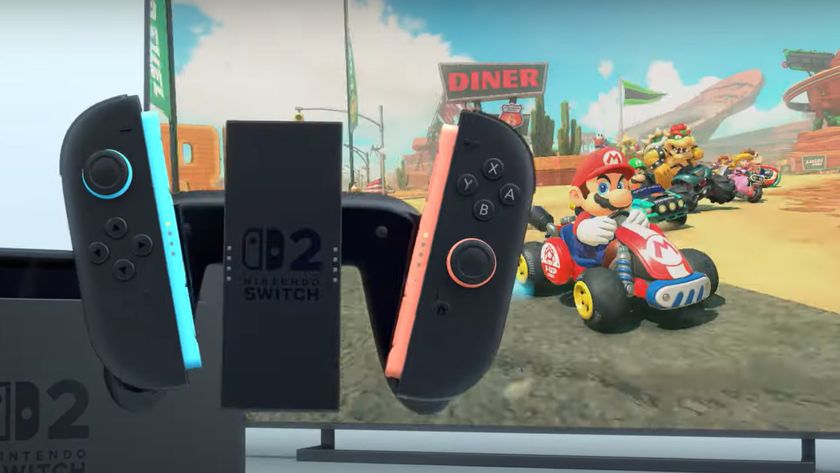
Ex Nintendo PR managers say the Switch 2 generation is likely to see the retirement of "several of the major developers at Nintendo who we have known for 40 something years"

Helldivers 2 CEO says industry layoffs have seen "very little accountability" from executives who "let go of one third of the company because you made stupid decisions"

Spider-Man: Brand New Day - How Peter Parker and Mary Jane's break up led to one of the wall-crawler's most transformative comic eras
